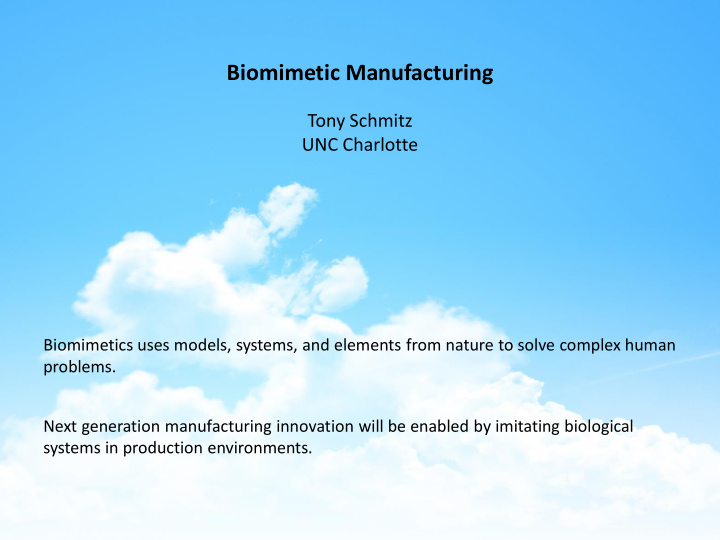



Biomimetic Manufacturing Tony Schmitz UNC Charlotte Biomimetics uses models, systems, and elements from nature to solve complex human problems. Next generation manufacturing innovation will be enabled by imitating biological systems in production environments.
Well-known biomimetic examples Lotus leaf Gecko feet Flapping wing MAVs Velcro Sharkskin swimsuit 2
Let’s consider five possible sources for biomimetic manufacturing inspiration: Trees Bean sprouts Termites Beaver teeth Zika virus. 3
Trees Growth pattern provides strength and geometry Meristems are locations of cell division that provide tree growth Apical meristems are found at branch and root tips Vascular cambium enables diameter growth 4
Tree growth is not layer-by-layer. A “layered” tree: wouldn’t last in a strong wind would require support material when growing new branches. Support material Blue sky question: Should additive manufacturing proceed in layers or could other approaches be applied that mimic tree growth? Are other addition (growth) strategies available that could increase isotropy, strength, fatigue life, or surface quality? 5
Beans sprouts water dissolves the hard seed casing casing splits roots emerge and unfurl from the seed leaf growth begins pair of leaves unwrap from the stem. 6
How do we currently create deployable assemblies? manufacture parts assemble fold deploy. Unfurlable mesh reflector antenna concepts Blue sky question: Could new materials and designs be created that enable assemblies to be produced monolithically and then deployed? What about a UV un -curable polymer? Print the device closed and then “ un-cure ” it to deploy. 7
Termites communicate by vibrations swarm to produce a new colony produce enzymes that break down wood cellulose into sugars they can digest. 8
Wood digestion Termite poop Break down wood cellulose with protozoa and bacteria into digestible sugars 9
Termites are normally considered a pest, but can we leverage their behavior for manufacturing? Blue sky question: Can we realize tailored material removal using a termite swarm concept? Can we create a new “machining” paradigm using: a swarm of autonomous meso-scale robots massively parallel material removal, including internal features part “digestion”, waste collection, and recycling controlled number/density of robots controlled “eating” direction and rate? 10
Beaver teeth incisors are self-sharpening outer surface composed of hard enamel inner portion made of softer dentin. As the dentin quickly wears, the cutting edge remains sharp. The tooth also continuously grows, which compensates for the high dentin wear rate. 11
Blue sky question: Could cutting tool designs evolve to accommodate, rather than minimize, wear and subsequently improve machining productivity? Instead of new coating/material technology, could new designs “ grow ” at an appropriate rate and self-sharpen using the hard/soft layer concept? 12
Zika virus spread primarily by mosquitoes first isolated in Uganda (1947) spread to the Americas starting in 2007 2015-16 epidemic no vaccine. 13
Digital twin computerized companion of physical asset data can include CAD/CAM, processing, geometry, property information can represent (near) real-time status, working condition, or position. Blue sky question: Can we share the digital twin with everything a part touches creating a data “outbreak”? The digital twin becomes the digital army when computerized part information spreads like the Zika virus. Will create new “ big data ” management questions. 14
Research possibilities + … education opportunities intersection of manufacturing science and biology will promote cross-pollination of two disciplines biological programs are typically more diverse than manufacturing with a much higher percentage of female students provide a much-needed step change in manufacturing research participation by under-represented groups inherently lead to innovation through increased diversity. In remembrance Biomimetic Manufacturing Tony Schmitz UNC Charlotte Questions? 15
Recommend
More recommend